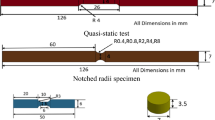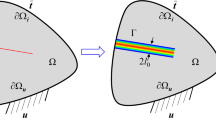Abstract
In order to obtain a constitutive model that can accurately describe the stress flow law of 05Cr17Ni4Cu4Nb stainless steel in extrusion forming process of spherical plain bearings, the quasi-static tensile tests of this material were carried out at room temperature in this paper, the engineering stress-strain curves of the material were obtained. Six constitutive equations were obtained by fitting the stress-strain data between the yield point and the necking point, the errors of the six models with the experimental data were analyzed. The results indicate that the Swift-Voce constitutive model had the highest correlation coefficient, the smallest mean square deviation with the experimental data and the best prediction accuracy at pre-necking and post-necking stage. Therefore, the Swift-Voce constitutive model was selected as the constitutive model of 05Cr17Ni4Cu4Nb stainless steel with large deformation at room temperature, and the finite element simulation technology was used to verify the Swift-Voce constitutive model. Once again, the simulation results show that, the stress-strain curve at pre-necking stage of the material is in good agreement with the test data. This constitutive model established in this paper can accurately describe the stress flow behavior of the material at room temperature.
Similar content being viewed by others
Abbreviations
- σ E :
-
Engineering stress
- σ T :
-
True stress
- σ S :
-
Material yield stress
- σ Ludwik :
-
Flow stress of Ludwik model
- σ Swft :
-
Flow stress of Swift model
- σ H-S :
-
Flow stress of Hockett-Sherby model
- σ Voce :
-
Flow stress of Voce model
- σ S-V :
-
Flow stress of Swift-Voce model
- σ Voce++ :
-
Flow stress of Voce++ model
- ε E :
-
Engineering strain
- ε T :
-
True strain
- ε p :
-
Plastic strain
- ε 0 :
-
Material yield strain
- n:
-
Strain hardening exponent
- KL, KS, KS-H, KV, KS-V, KV++, m, C, D:
-
Material strength coefficients need to be fitted
References
A. Orsolini and J. D. Booker, Modelling capabilities required for the double nosing process in the assembly of spherical plain bearings, Journal of Engineering Manufacture, 226(5) (2012) 930–940.
J. G. Chen et al., Current status and development trends of forming technology for spherical plain bearing with one-piece outer ring, Bearing, 56(9) (2013) 58–62.
X. M. Wang and S. W. Lv, Numerical investigation on press forming of self-lubricating spherical plain bearings, Internal Journal of Materials and Product Technology, 47(4) (2013) 46–62.
L. L. Zhu, Numerical simulation on extrusion forming of integral self-lubricating spherical plain bearings, Journal of Plasticity Engineering, 27(1) (2020) 21–26.
Z. He et al., Experimental investigation of the dynamic material property of stainless steel: 0Cr17Ni4Cu4Nb, Journal of Materials Science and Engineering, 25(3) (2007) 418–421.
L. R. Heim, Method for Manufacturing spherical Bearings, Patent No. US3221391A, US Patent and Trademark Office (1965).
A. R. McCloskey, Method of Manufacturing spherical Bearings, Patent No. EP0054592A1, European Patent Office (1982).
J. Woodhead et al., Measurement of forming stresses in plain spherical bearings using neutron diffraction, Materials Science Forum, 777 (2014) 58–64.
J. Woodhead and J. D. Booker, Modelling of nosing for assembly of aerospace bearing, Experimental and Applied Mechanics, 38 (2013) 327–338.
L. M. Alves and P. A. F. Martins, Single-stage nosing of thin-walled tubes into hollow spheres using a die, Journal of strain Analysis for Engineering Design, 43 (2008) 205–216.
P. Koc and B. Stok, Computer aided identification of the yield curve of a sheet metal after onset of necking, Computational Materials Science, 31 (2004) 155–168.
X. Li, H. B. Zhang and X. Y. Ruan, Analysis and modeling of flow stress of 40Cr steel, Material Enginnering, 11 (2004) 41–44.
E. Lee et al., Study on design of progressive dies for manufacture of automobile structural member using DP980 advanced high strength steel, Journal of Mechanical Science and Technology, 30(2) (2016) 853–864.
H. J. Kleemola and M. A. Nieminen, On the strain-hardening parameters of metals, Metallurgical Transactions, 5(8) (1974) 1863–1866.
S. Dziallach et al., Sheet metal testing and flow curve determination under multiaxial conditions, Advanced Engineering Materials, 9(11) (2007) 987–994.
A. Lavakuma et al., A new empirical equation to describe the strain hardening behavior of steels and other metallic materials, Materials Science and Engineering A, 802 (2021) 1–10.
R. Grissa et al., Efficient constitutive material model for predicting residual stresses induced by orthogonal cutting, Journal of Mechanical Science and Technology, 32(6) (2018) 2765–2771.
J. Cai et al., Constitutive equations for elevated temperature flow stress of Ti-6Al-4V alloy considering the effect of strain, Materials and Design, 32(3) (2011) 1144–1151.
H. D. Kweon et al., A methodology for determining the true stress-strain curve of SA-508 low alloy steel from a tensile test with finite element analysis, Journal of Mechanical Science and Technology, 32(7) (2018) 3137–3143.
G. Capilla et al., Determination of uniaxial large-strain work-hardening of high-strength steel sheets from in-plane stretchbending testing, Journal of Materials Processing Technology, 243 (2017) 152–169.
M. C. Oliveira et al., A modified Hockett-Sherby law enabling the description of the thermomechanical behavior of the AA6061-T6, Procedia Manufacturing, 47 (2020) 896–903.
H. C. Ho et al., Determination of a full range constitutive model for high strength S690 steels, Journal of Constructional Steel Research, 174 (2020) 1–16.
J. Q. Guo et al., Elastic-plastic endochronic constitutive model of 0Crl7Ni4Cu4Nb stainless steels, Mathematical Problems in Engineering (2016) 4396296.
Y. H. Xiao et al., High temperature deformation behavior and constitutive modelling for 05Cr17Ni4Cu4Nb stainless steel, Procedia Engineering, 81 (2014) 1277–1282.
H. Y. Li et al., Study on material flow stress model, Die and Mould Technology, 26(5) (2009) 1–4.
M. Kim et al., Determination of post-necking stress-strain relationship for zirconium low-oxidation based on actual cross-section measurements by DIC, Journal of Mechanical Science and Technology, 34(10) (2020) 4211–4217.
J. Jadav et al., Effect of temperature on tensile flow behavior of nimonic C-263 alloy, Materials Today: Proceedings, 5 (2018) 5475–5480.
H. D. Kweon et al., Determination of true stress-strain curve of type 304 and 316 stainless steels using a typical tensile test and finite element analysis, Nuclear Engineering and Technology, 53 (2021) 647–656.
Y. K. Dong and J. J. Qi, Applicability of hardening models for automobile steel sheets, Materials for Mechanical Engineering, 44(10) (2020) 81–86.
M. K. Gupta and N. K. Singh, Modelling and simulation on deformation behavior of Al2014-T6 alloy beyond necking, Materials Today: Proceedings, 44(6) (2021) 4204–4208.
Q. T. Pham et al., Influence of the post-necking prediction of hardening law on the theoretical forming limit curve of aluminum sheets, International Journal of Mechanical Sciences, 140 (2018) 521–536.
G. Y. He et al., Evaluation of the elastic-plastic properties of TiN coating by nano indentation technologies using FEM-reverse algorithm, Surface and Coatings Technology, 409 (2021) 126855.
K. M. Zhao et al., Identification of post-necking stress-strain curve for sheet metals by inverse method, Mechanics of Materials, 92 (2016) 107–118.
DIN 50150:2000–10, Testing of Metallic Materials — Conversion of Hardness Values, Deutsches Institut fur Normung E.V. (2000).
N. Su et al., Constitutive modeling of 17-4PH stainless steel sheet at elevated temperature and statistical optimization, Journal of Materials Engineering and Performance, 29 (2020) 1194–1205.
Acknowledgments
This work is supported by Shanghai Science and Technology Commission (Research and manufacture of serial robot cross roller bearing 20511105602), China.
Author information
Authors and Affiliations
Corresponding author
Additional information
Linlin Zhu received her Master degree in Mechanical Manufacturing from Harbin Engineering University in 2013 China. Now, she is a Senior Engineer, working in technical department of Shanghai Bearing Technology Research Institute, China. Her research interests include plastic forming of metal, spherical bearing assemble technology and engineering application of finite element analysis technique.
Xiongrong Huang received her master degree in Material from Tongji University in 2009, China. She works as a Senior Engineer and the Director of Technical Department of Shanghai Bearing Technology Research Institute, China. Her research interests include special bearing design, bearing material application research, friction surface modification technology and failure analysis. She developed a kind of self-lubricating spherical bearing that are resistant with high temperature and corrosion.
Rights and permissions
About this article
Cite this article
Zhu, L., Huang, X. & Liu, H. Study on constitutive model of 05Cr17Ni4Cu4Nb stainless steel based on quasi-static tensile test. J Mech Sci Technol 36, 2871–2878 (2022). https://doi.org/10.1007/s12206-022-0519-6
Received:
Revised:
Accepted:
Published:
Issue Date:
DOI: https://doi.org/10.1007/s12206-022-0519-6




